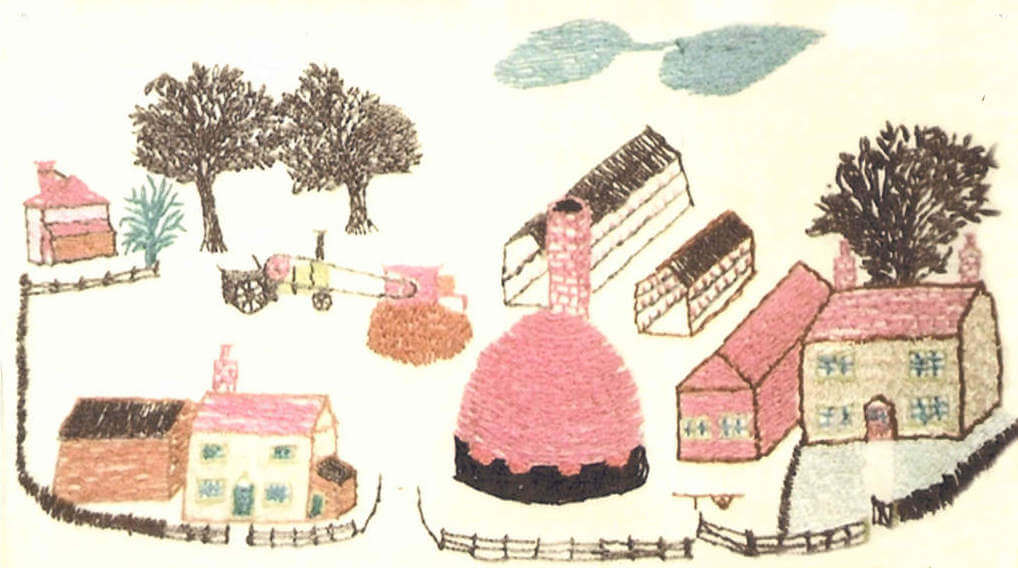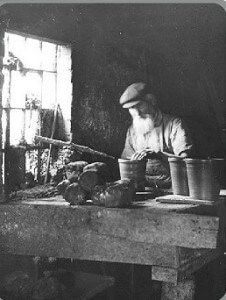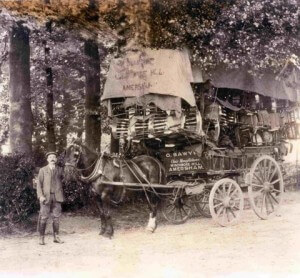
Other pages about Winchmore Hill: 150 years of the Methodists (pdf download), Those who died in World War 1, VE Day celebrations in 1945.
This page is based on a display board written by Stephen C. Palmer and jointly commissioned and supported in 2015 by the Penn Parish Council, the Winchmore Hill Residents Association and the Trustees of the Winchmore Hill Memorial Hall.

Winchmore Hill stretches back to about the 12th century with a small settlement supporting farms grouped round a Common and a pond. In 1958 the pond was filled in but the Common survives, on the fringes of what was once Wycombe Heath, 4,000 acres of open common land providing grazing for animals and a source of firewood and building materials. The hamlet straddled three separate parishes- Amersham, Penn and Coleshill (a detached part of Hertfordshire until 1844). This sharp boundary, at the crossroads and once marked by a stone, may provide the derivation of our name – ‘wincel’ being an old English word meaning a corner or angle and ‘maer’ a boundary.
By the 17th century, a number of larger farms had been established down Fagnall Lane -Glory Farm, Fagnall and Lowlands. The villages shared two common fields divided into strips – Collins and Horsemoor, with the strip holdings on Horsemoor surviving until 1855. There still exist about 8 houses in the village with probable 17th century origins, including ‘The Plough’. As well as four pubs, there used to be three shops in the vaillage.
Children from Winchmore Hill have always attended two local schools, at Coleshill and Penn Street. A plan in 1913 to establish a school within the village was abandoned because of local opposition.
In the First World War about 50 men from the village and surrounding area volunteered or were called-up and the names of 18 men killed are commemorated at the Memorial Hall. The Hall was opened in November 1921, a much-appreciated and lasting tribute to those brave men.
Since the 1930s the chair-factories in the village have closed, the demand for agricultural labourers has sharply reduced and people have become more mobile. Employment has diversified with various local trades and some commuting to London. The original division between three parishes was superseded in 1955 when the village voted to become part of Penn Parish. The population of Winchmore Hill in 2015 is about 550 in 240 households.
Pottery, tiles and bricks

Clay in the Chilterns area is highly suitable for the production of pottery, tiles and bricks. By 1726 pots were being made in Coleshill Lane, Winchmore Hill, with a working shop, kiln house and stable owned by William Bovingdon. There were several other potteries nearby in Coleshill and Penn.
In the 1770s a pot-kiln and workshops were erected overlooking The Common, on the corner of Fagnall Lane, and manufacture at this important Pottery continued throughout the19thcentury. A range of domestic ‘brown ware’ was produced, including bread-pans, milk pans and flower-pots, and taken to neighbouring market-towns by pack-horse. By 1830 the adjacent ‘Potters Arms’ was a beer house, and later in the century the publican was often also the owner of the pottery.

Opposite the Potters Arms, a Wesleyan Methodist Chapel was opened in 1861, reflecting a strong Methodist tradition within the village. A Primitive Methodist Chapel was built on The Hill in 1860 and regular services continue to this day.
In the early 20th century, the Pottery was owned by Joseph Hobbs. It was finally demolished in 1932 and the bricks were used to build the semi-detached houses now on that site. One of the last potters to work at Winchmore Hill was Thomas Sears, one of a family living in the village through several generations.
[Listen to Stuart King’s 1983 recording about the Potters of Winchmore Hill]
Chair-making

18th century improvements in road transport enabled Buckinghamshire carpenters in the Chilterns area to assemble furniture and chairs for the London market, based on plentiful local supplies of beechwood. A number of chair-manufacturers became established in Amersham, and in 1845 David Hatch set up his business as a chair-maker near the ‘Queens Head’ in Whielden Lane. The family business prospered, employing some 30 men by 1900.
George Pursey, innkeeper of ‘The Plough’, built a saw-pit and a row of sheds in about 1870 for turning chair-legs. Other small factories were established on The Hill and in Coleshill Lane and Fagnall Lane. By 1901 Chair-making was in fact the main village employment. According to the 1901 Census, 46 out of 99 men in Winchmore Hill worked in chair-making compared with 31 agricultural labourers. Local farms were mainly arable – wheat, barley and oats- but cherries were also an important local crop.
William Pursey established another chair-factory on the west side of The Hill. This business was taken over by Frederick Rose in 1922, in partnership with Frederick Sears and Sidney Hext. In 1964 the business was sold to Gordon Fassnidge. Around this time, the firm employed 28 people, making up to 1,000 chairs a week. It was the last surviving chair-factory in Winchmore Hill, and continued until 1988.

The last chair-maker in the village was life-time resident Eric Hazell, who died in October 2014, aged 91. His predecessors had also lived in the village, and this text is a tribute to Eric and other local families stretching back through the generations who have given strength, character and history to Winchmore Hill.

